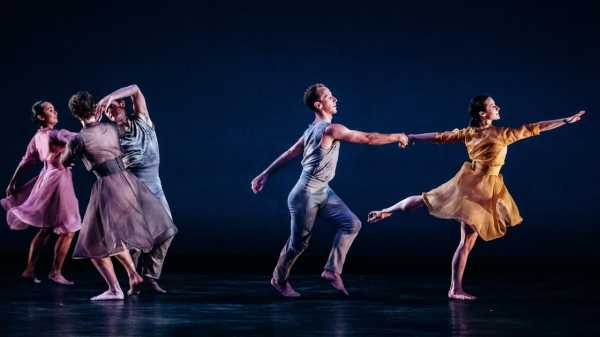
“It’s difficult to write music that is consistently happy all the way through,” the excellent musicologist Christopher Hogwood said in a 2012 lecture on Schubert’s “Trout” Quintet. But, in Hogwood’s view, Schubert did it in the “Trout.” Mark Morris’s “The Trout,” set to that quintet, had its première last week, at the Rose Theatre, as part of the Mostly Mozart Festival. It, too, is happy pretty much all the way through. And what a pleasure it is, with an artist you’ve watched harrowing hell on a regular basis for several decades, to see him just have a good time.
The dance begins with simple walking and then, as more dancers come onstage, proceeds to running. The dancers’ manner is very companionate, a mode that, as much as the hellfire, is a Mark Morris trademark. But unlike other Morris dances in the happy-family key, the piece stays that way for a long time. Not that it remains simple. On the contrary, it gets more elaborate by the minute. The dancers start to turn and jump. The runs start travelling backward and sideways. And we begin to see a little maneuver that will recur: a woman, with her back to us and her legs somewhat apart, leans forward and is lifted maybe two feet into the air, so that her dress whooshes up in back (the beautiful chiffon dresses, in colors we don’t normally associate with chiffon—teal, navy blue, yellow—are by Maile Okamura), and we glimpse her little bottom, albeit discreetly covered. How Mark Morris-like this move seems! How amazing that (as I recall) he never used it before! For nearly forty years he has been making extensive use of the dancers’ rear ends—“I love to see their butts,” he once said—and getting them to tell of sex and vulnerability and the hard work of dancing, and now he has found a new way to do it. Still, the piece stays pretty sweet. The dancers enjoy themselves. They skip.
Finally, the mood breaks. In the fourth movement, the dancers suddenly fall to the floor as if they are being attacked by an enemy battalion. Dallas McMurray seems to be wounded; Domingo Estrada carries him off the field. Lesley Garrison crawls on the ground. Brandon Randolph picks his way among the bodies. But then this, too, comes to an end. It was just a break that Morris needed, to remind us that life is not so sweet, and to give vent to his sometimes black hilarity. In any case, the dancers soon reappear, in good health, and in the final movement they do something that looks like a folk dance. Indeed, it looks like Marius Petipa’s czardas from “Swan Lake.”
Sometimes I think that Morris is a surrealist. In any case, it’s a joy—always, with him—to see such a train wreck of emotions. And even when the dance was sweet, it wasn’t, after all, really that sweet. Schubert built this quintet on a song, “The Trout,” that he had written some years earlier. The song had a humble little lyric, by a now forgotten poet, Christian Friedrich Daniel Schubart, about trout fishing. In Schubart’s verse, the trout swims around happily in the clear, sparkling water for a few stanzas; that’s the wiggly little figure that we keep hearing, now in the strings, now in the piano’s high notes. But finally the fish is caught on the hook, and struggling and dying. So it will be for us, too—a truth buried in Schubert’s composition, and also in Morris’s.
Sourse: newyorker.com






